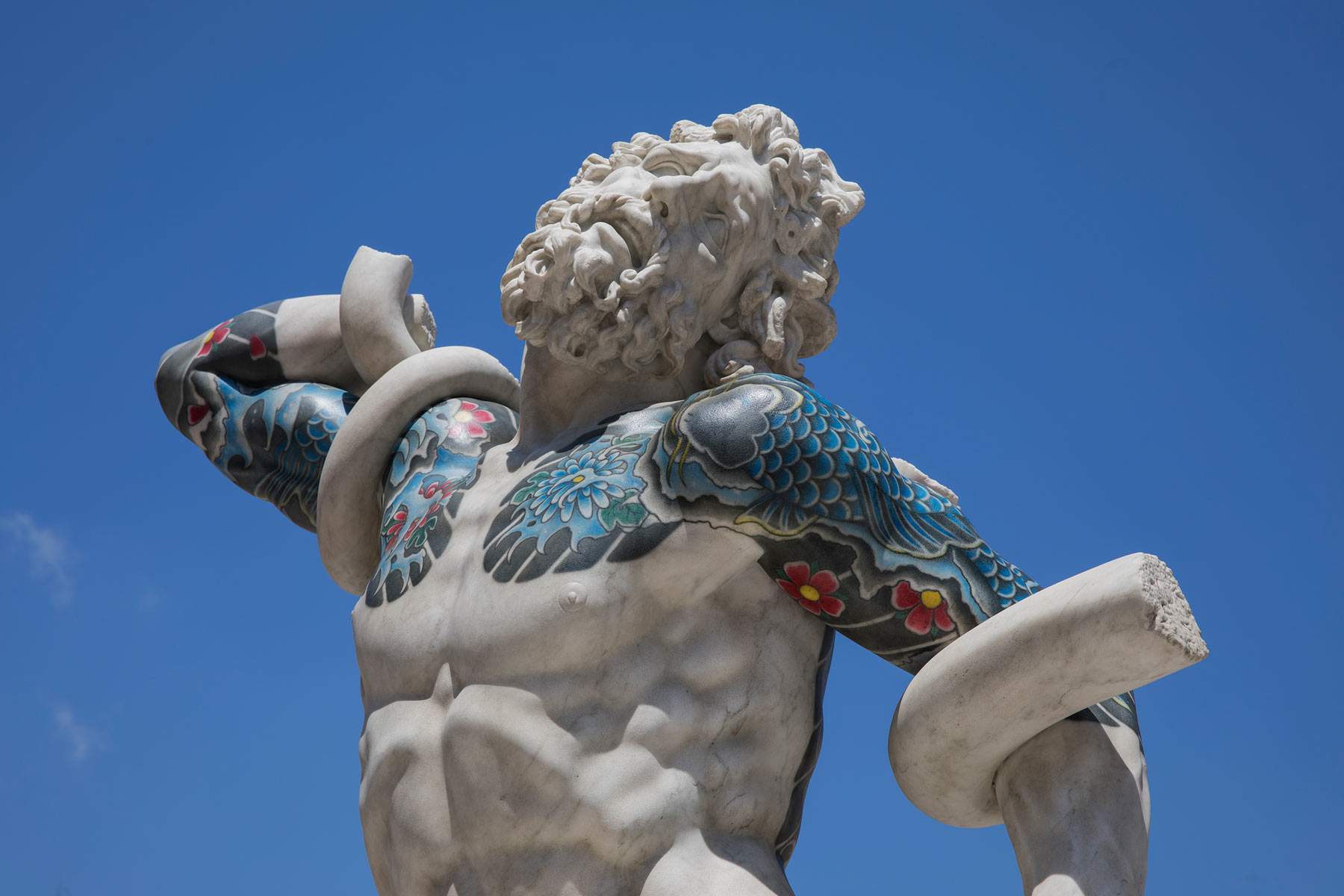Truly, Fabio Viale's exhibition in Pietrasanta invites reflection on our concept of freedom
Truly, a solo exhibition by Fabio Viale (Cuneo, Italy, 1975), opens today in Pietrasanta, Italy. The exhibition, curated by Enrico Mattei, runs until Oct. 4, 2020, and is realized with the support of Galleria Poggiali in Florence. The exhibition was created with the intention of exhibiting works in dialogue with city spaces: the intent of Fabio Viale is to interpret the sense of our days of forced isolation. Responding to this need, for example, is the exhibition of Le Tre Grazie, which the artist is premiering inside the church of Sant’Agostino.
The work, in white marble, has as its subjects three women from Ghardaia, an Algerian city of the Ibadite Islamic religion where the woman wears the traditional haik, a wide white robe down to her feet, wrapped around her body and face that leaves only one eye uncovered. Viale, who came into contact with this city during one of his frequent travels, wishes to focus particular attention on the theme of denied freedom and at the same time on the taken-for-granted perception of it by Westerners, who, just now, in times of severe constraint, feel its extent.
Responding to the stimulus of the new iconography to which we are all subjected (the so-called “personal protective devices,” particularly the masks on the face, with which we are and will be widely familiar, but to which we were not accustomed), The Three Graces aspires to create a visual and semantic short-circuit that, despite its title, has no classical reference: connecting to the symbolism of the veil and the experience of social distancing, based on distrust of one’s neighbor, especially if covered, the sculpture opens up to religious and behavioral meanings. The placement of the sculpture in the church of St. Augustine is intended to heighten its mystical and symbolic bearing by evoking a dialogue on the themes of spirituality, personal freedom, worship and meditation, also suggested by the installation choice that sees it juxtaposed with Star Gate, a sculpture made of arabesque marble from Mount Altissimo that depicts two monumental fruit boxes (2 meters high), which united leave a gap in space, a passage, and at the same time, a limit to be crossed to which are associated portals of new spirituality and emancipation.
As Sergio Risaliti, director of the Novecento Museum in Florence and author of an essay in the catalog, argues, “at the basis of Viale’s work there is always a respectful knowledge of the material, and it is thanks to this virtuous relationship, cultivated over the years, between technique and poetry, between materials and tools, between man and nature, that a creative process has been perfected whose purpose is, net of other considerations, the exaltation of the formal properties of stone and of the conceptual and figurative ones in the human imagination.”
Again, the exhibition includes the installation in the Cathedral Square of some large-scale tattooed marbles. The marks made on the marble are a personal combination of the most current tattooing trends, from the tried-and-true tattoos of the criminal and Japanese worlds, to new directions from the South American and Trapper worlds. Confirming the artist’s aptitude for decoding modern-day sensibilities, Viale composes an unprecedented cross-media language that draws on a kind of “Old Style” sign universe. Prominent among these works are Souvenir David (a sort of monumental mask of Michelangelo’s David, on which the artist experimented for the first time with this new type of tattoo), a large torso inspired by the Torso dek Belvedere, and an unprecedented work: a torso inspired by the Gaddi Torso that will feature the collaboration of fashion designer Marcelo Burlon. On the marble surface, his motifs, a mix of natural elements and contemporary styles, will be tattooed.
The cloister of Sant’Agostino and the adjacent rooms on the ground floor will also feature a series of works that have marked the artist’s journey: from Infinito, a black marble sculpture representing the intertwined wheels of an SUV, to a version of La Suprema depicting two wood-effect fruit crates. Finally, in Marina di Pietrasanta, placed right on the Marina Pier commonly, an additional work in white marble will be exhibited. On the occasion of the exhibition, a catalog with texts by Enrico Mattei, Sergio Risaliti and Massimiliano Simoni will be published, and its presentation to the public will take place on Saturday, August 1, 2020.
Below are photos of some of the works.
 |
| Fabio Viale, The Three Graces (2020; marble). Courtesy the artist and Galleria Poggiali. Photo credit © Nicola Gnesi |
 |
| Fabio Viale, Truly, installation view. Courtesy the artist and Galleria Poggiali. Photo credit © Nicola Gnesi |
 |
| Fabio Viale, Truly, installation view. Courtesy the artist and Galleria Poggiali. Photo credit © Nicola Gnesi |
 |
| Fabio Viale, Truly, installation view. Courtesy the artist and Galleria Poggiali. Photo credit © Nicola Gnesi |
 |
| Fabio Viale, Truly, installation view. Courtesy the artist and Galleria Poggiali. Photo credit © Nicola Gnesi |
 |
| Truly, Fabio Viale's exhibition in Pietrasanta invites reflection on our concept of freedom |
Warning: the translation into English of the original Italian article was created using automatic tools. We undertake to review all articles, but we do not guarantee the total absence of inaccuracies in the translation due to the program. You can find the original by clicking on the ITA button. If you find any mistake,please contact us.





























